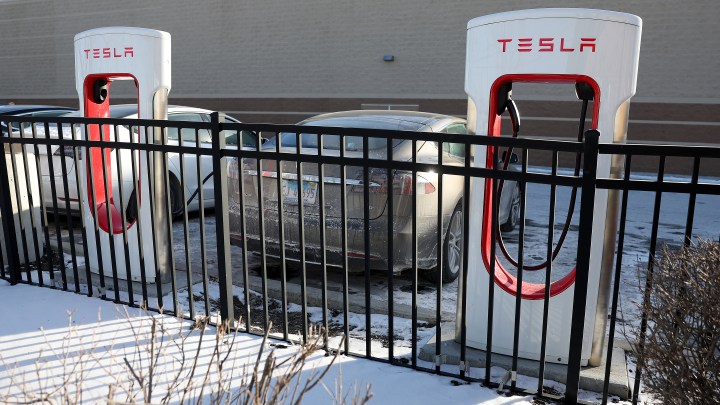
Turns out EVs don’t like the cold either

With much of the country frozen right now, some electric vehicle owners may be going through their first cold winter and finding that their cars aren’t charging as quickly or holding charge as long.
There have been reports out of Chicago this week of long lines of Tesla drivers waiting for a charger — and some cars’ batteries running out before it was their turn.
You know how when you put honey in the fridge and it gets cold, it moves a lot more slowly? That’s basically what happens to batteries when they get cold too, including the ones in electric cars, explained Dan Steingart, co-director of the Columbia Electrochemical Energy Center.
“The ions that have to move from one side of the battery to the other side of the battery to give us the power we need also slow down significantly,” he said.
Most of the time, Steingart said this doesn’t change how EVs run, “because the car works very hard to keep the battery at a consistent temperature. So if you keep the car plugged in overnight — in particular, if you keep the car plugged in in a garage — you shouldn’t really notice this.”
If you can’t keep it in a garage or plugged in at night and it gets really cold out, you’re going to notice. For one thing, the car’s going to take longer to charge, said Graham Evans at S&P Global Mobility.
“There’s definitely this kind of sweet spot for a battery to operate somewhere in the region of 77 degrees Fahrenheit,” he said.
So, if the car’s been sitting outside in the cold overnight, “when people are trying to charge first thing, they plug in, they try and receive a very high power level of charge, the vehicle will struggle to receive the charge,” said Evans.
The other thing that happens to EVs when it’s really cold out is that they lose range, per Gil Tal at UC Davis.
“And it’s losing range both because the battery is too cold to give the optimal performance and also because we use energy to heat the car, to heat the cabin, to heat ourselves,” he said.
So if you normally get 400 miles out of a full battery charge, you might only get 200 or 300 miles depending on the car and how cold it is.
“And there is no way around it,” Tal said. “We just need to plan for it.”
For now, Tal said that’s the solution: If you know it’s going to be very cold, find a way to plug the car in or be prepared for charging to take longer.
Columbia’s Dan Steingart said that engineers — including in his lab — are working on this.
“Batteries beforehand were designed to work near and around room temperature, because our laptops and our phones were either inside or in our pockets near us, and we like to be at room temperature,” he said.
So, batteries were optimized for that fairly narrow range. But now that we’re increasingly using these kinds of batteries in things — like cars — that need to operate when it’s really hot and when it’s really cold?
“It’s the new frontier of battery engineering, to make it so that batteries are happier at multiple temperatures,” said Steingart.
And he expects there will be a lot of progress on this front in the next 10 years.
There’s a lot happening in the world. Through it all, Marketplace is here for you.
You rely on Marketplace to break down the world’s events and tell you how it affects you in a fact-based, approachable way. We rely on your financial support to keep making that possible.
Your donation today powers the independent journalism that you rely on. For just $5/month, you can help sustain Marketplace so we can keep reporting on the things that matter to you.

















